Guitar tablature, commonly known as “guitar tabs,” offers an accessible gateway for aspiring guitarists to swiftly learn and play their favorite songs. Functioning as a simplified form of musical notation, guitar tabs share common ground with standard music staff notation by illustrating notes, rhythm, and playing techniques. However, guitar tabs distinguish themselves by clearly indicating where to play those notes on the guitar, a significant advantage over traditional notation, especially for beginners.
This is particularly beneficial given the guitar’s layout, where the same note can often be played in multiple locations across the fretboard. Understanding guitar tablature and learning how to read Guitar Tab Sheets is therefore an invaluable skill for beginners. It allows students to embark on their guitar journey and learn to play songs without the initial hurdle of mastering standard musical notation.
At guitarplayers.net, we understand the importance of making guitar learning accessible. That’s why we guide our users on how to read guitar tab sheets. Guitar tabs effectively represent both chords and single notes, making them a remarkably efficient tool for learning songs quickly. The beauty of guitar tabs lies in their simplicity; no prior musical knowledge is required beyond understanding the layout of strings and frets on your guitar.
If you’re eager to demystify guitar tab sheets and explore their potential, you’ve landed in the perfect spot. Let’s dive in and unlock the world of guitar tabs together.
WHAT ARE GUITAR TAB SHEETS?
A guitar tab sheet is essentially a visual representation of a song’s musical notes, specifically tailored for the guitar. A standard guitar tab sheet is composed of six horizontal lines, each corresponding to one of the six guitar strings. When you learn how to read tab sheets for guitar, you’ll read them from top to bottom. The topmost line signifies the high E string (the thinnest string), followed by lines for the B, G, D, A, and low E strings (the thickest string).
This arrangement mirrors the perspective you have when looking down at your guitar while playing. Think of a guitar tab sheet as your personal roadmap to musical fluency, offering the quickest route to playing your favorite guitar tracks.
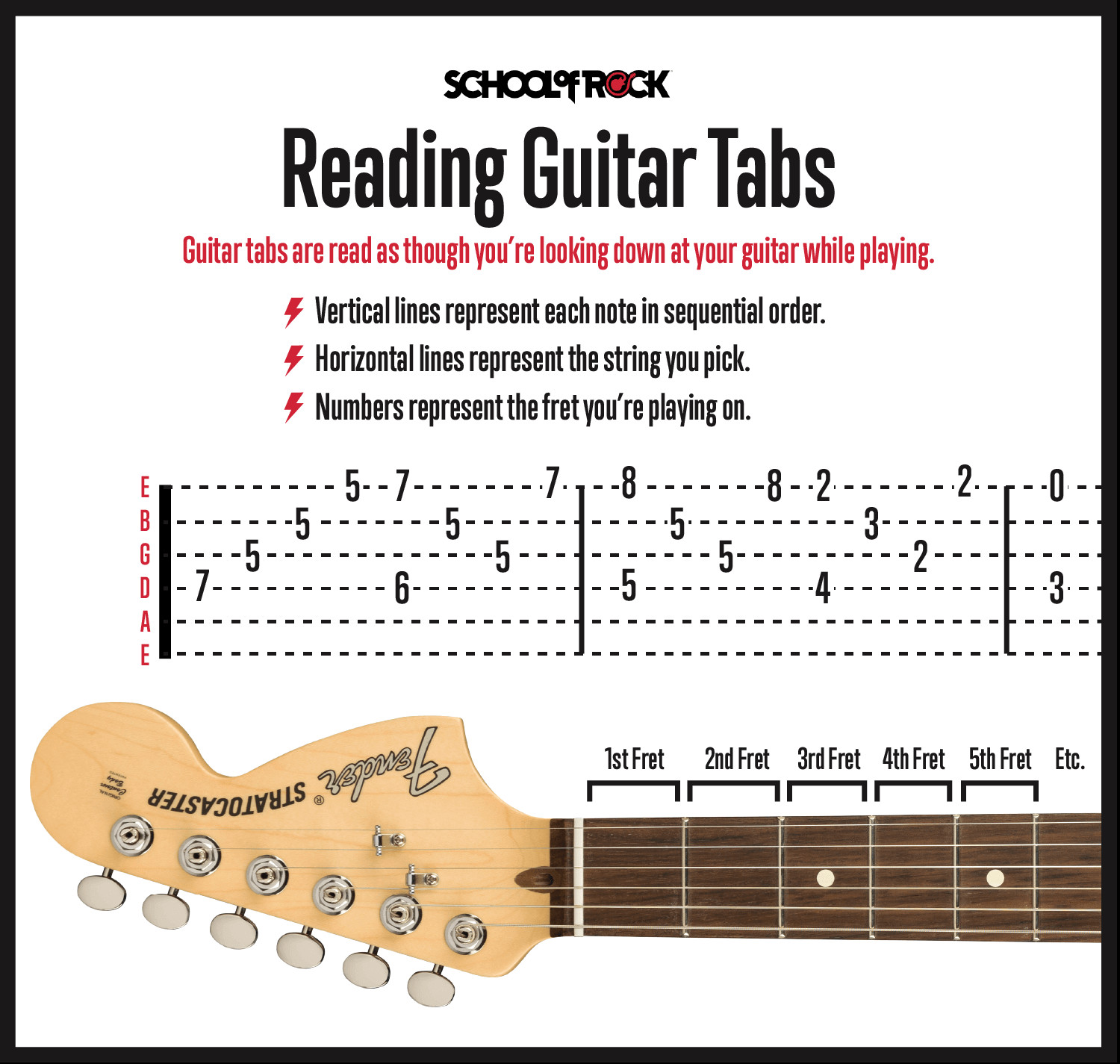 Reading guitar tabs
Reading guitar tabs
Within a guitar tab sheet, you’ll notice numbers positioned on each line. These numbers represent the frets on your guitar, the metal strips running across the fretboard. Frets are numbered from 0 to 24, starting at the nut (closest to the headstock) and extending along the neck.
A “0” on a string indicates playing that string “open,” meaning without pressing down on any fret with your fretting hand. A “1” signifies playing at the first fret. When you’re learning how to read guitar tab sheets, it’s crucial to remember that “1” denotes the first fret, “2” the second fret, “3” the third fret, and so on.
 Play Button
Play Button
HOW TO READ GUITAR TAB SHEETS
Guitar tab sheets are read from left to right, with the notes presented in the order they are played. When numbers align vertically, they represent a chord. A chord is played by strumming all the indicated strings simultaneously. Guitar tab notation is particularly advantageous for beginners compared to standard notation because it not only tells you which notes form a chord but also precisely where to find them on your guitar.
ESSENTIAL KNOWLEDGE FOR READING GUITAR TAB SHEETS
For beginners to successfully learn how to read guitar tab sheets, familiarizing themselves with the six strings and the fret positions is essential. This foundational knowledge allows them to locate the correct notes on their guitar while using the tab sheet as their guide.
DECIPHERING THE GUITAR TAB STAFF
The guitar tab staff visually resembles the staff used in standard musical notation. However, a key distinction lies in the staff lines: in guitar tabs, they represent the six guitar strings, not musical pitches.
The top line always represents the high E string, and the bottom line the low E string. This straightforward representation makes playing and learning how to read guitar tab sheets beginner-friendly. Furthermore, the staff is typically labeled “TAB” to avoid confusion with standard notation.
UNDERSTANDING GUITAR FRETS
Guitar frets are the thin metal strips embedded across the fretboard of your guitar.
Most guitars come equipped with anywhere from 19 to 24 frets. Each fret represents a single note or a half step (also known as a semitone) interval. Within each octave, there are 12 notes (or frets). To aid navigation, most guitars feature fret markers, often dots or inlays, on the side of the neck or directly on the fretboard, typically positioned at the 3rd, 5th, 7th, 9th, and 12th frets. These markers provide visual cues for easy fret position recognition while playing.
Remember, in guitar tab sheets, numbers denote fretted strings, while the number “0” signifies an open string. Playing an open string simply involves picking or plucking the string without pressing down on any fret, allowing it to ring freely.
UNDERSTANDING GUITAR TAB CHORDS
Guitar tab sheets represent chords through vertical alignment of notes, without using specialized symbols. When you see multiple numbers stacked vertically on the tab staff, it indicates a chord, meaning those notes are played together. Even if a chord is arpeggiated (played one note at a time), the tab will still display the individual notes sequentially, even though you are holding down a chord shape.
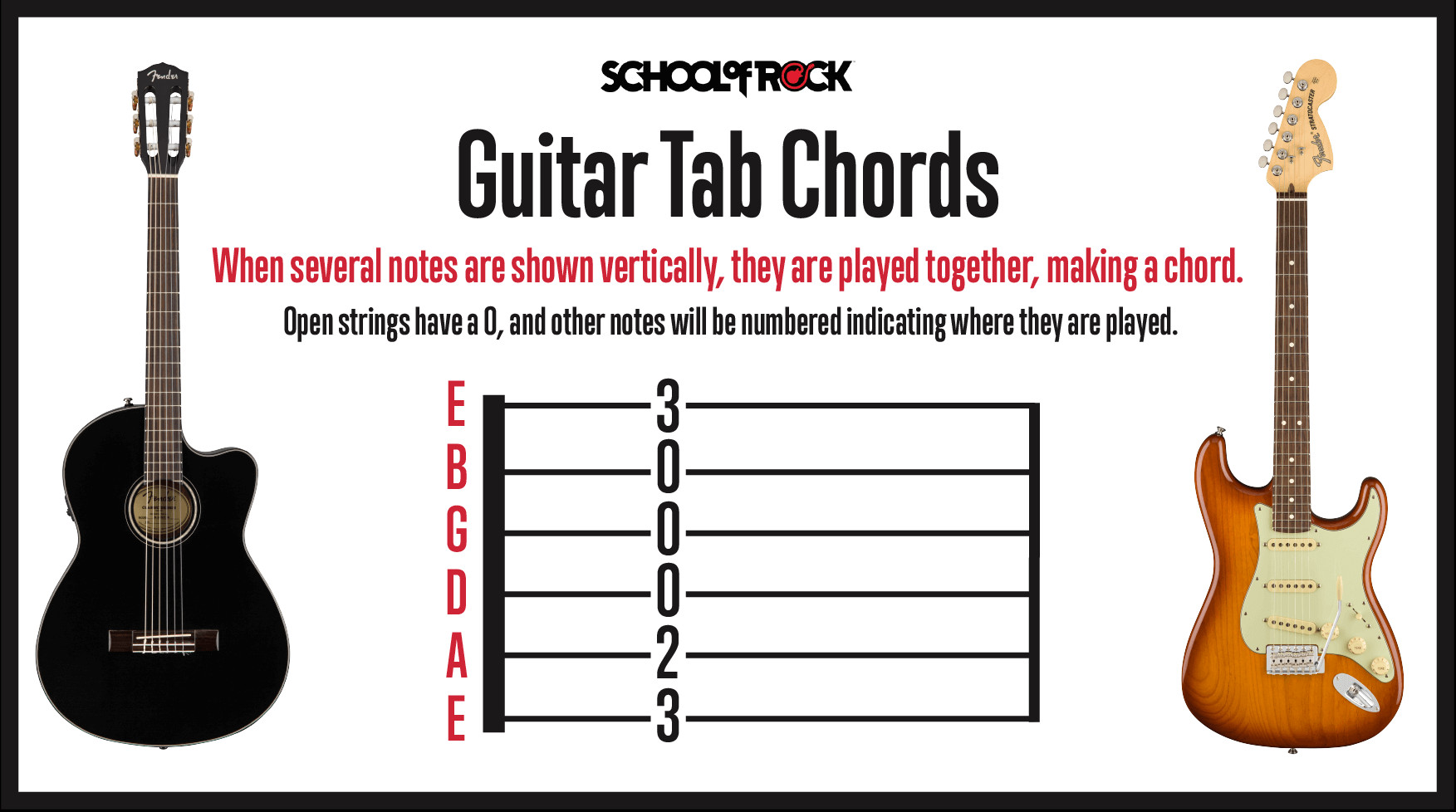 How to read guitar tab chords
How to read guitar tab chords
UNDERSTANDING GUITAR TAB RIFFS
Many rock songs are built upon “riffs,” which are short, repeating musical phrases. Riffs often combine single notes and partial chords, such as power chords. When reading riffs in guitar tab sheets, the fundamental rules still apply: vertically aligned notes are played simultaneously. This consistent approach simplifies learning how to read guitar tablature for riffs and melodies alike.
GUITAR TAB SHEETS VS. CHORD CHARTS
Guitar tab sheets and chord charts serve different but complementary purposes. A chord chart is a visual diagram illustrating where to place your fingers on the fretboard to form a specific chord. It often includes finger numbers for guidance. Chord charts are frequently incorporated into guitar tab sheets, positioned above song lyrics to indicate chord changes within the song’s structure.
Chord charts typically display only the essential 3-4 notes that constitute a chord. However, a full and accurate rendition of a song may involve single notes, notes outside the basic chord, or arpeggios (playing the notes of a chord individually in a pattern), which chord charts alone don’t capture. For this reason, chord charts often accompany guitar tab sheets, especially for beginners, to bridge the gap between basic chord playing and more nuanced song performance.
FINGERS AND NUMBERS IN TABS AND CHARTS
Guitar tab sheets and chord charts use numbers, but in different ways. Tab sheets are linear, representing the musical timeline, while chord charts are like snapshots of the fretboard at a given moment. Chord charts employ a numbering system to indicate which finger to use for each string. The fingers of your fretting hand are numbered: index finger (1), middle finger (2), ring finger (3), and pinky finger (4).
In contrast, numbers within guitar tab sheets represent fret numbers, not finger numbers. Therefore, chord charts are often included alongside beginner-friendly guitar tab sheets to guide hand positioning and fingering.
PLAY GUITAR IN REAL PERFORMANCES ON STAGE
Our music programs are led by experienced, practicing musicians who provide the expertise you need to learn and excel. Gain stage experience and refine your skills in a supportive environment tailored to all skill levels.
GUITAR TAB SHEET SYMBOLS: BEYOND NUMBERS
Beyond lines and numbers, guitar tab sheets utilize various symbols to indicate specific playing techniques. Understanding these symbols and how to execute the corresponding techniques is crucial for achieving authentic and nuanced guitar playing and makes reading guitar tab sheets even easier.
Before you start playing, always ensure your guitar tuning is accurate. Playing with incorrect tuning will significantly impact the sound.
MUTING GUITAR NOTES
Muting is a fundamental technique, especially in rock music genres like Heavy Metal, Punk, and Alternative, where it’s used to create specific sonic textures and rhythmic feels.
HOW TO MUTE GUITAR NOTES
Guitar muting, primarily executed with the picking hand, can also involve the fretting hand or both. Muting adds dynamic variation to your playing and is an essential tool for achieving a polished sound. Many songs utilize muting in verses for contrast with a non-muted chorus or hook.
Experienced guitarists often incorporate muting instinctively, especially at higher volumes, to eliminate unwanted noise or feedback during performance.
GUITAR TECHNIQUE: PALM MUTING
Palm muting is a ubiquitous technique in rock guitar. It involves lightly resting the palm of your picking hand on the strings near the bridge while picking. Heavy palm muting produces a tight, percussive sound, while lighter palm muting allows notes to sustain slightly longer. In guitar tab sheets, “P.M.” above a section indicates palm muting is required.
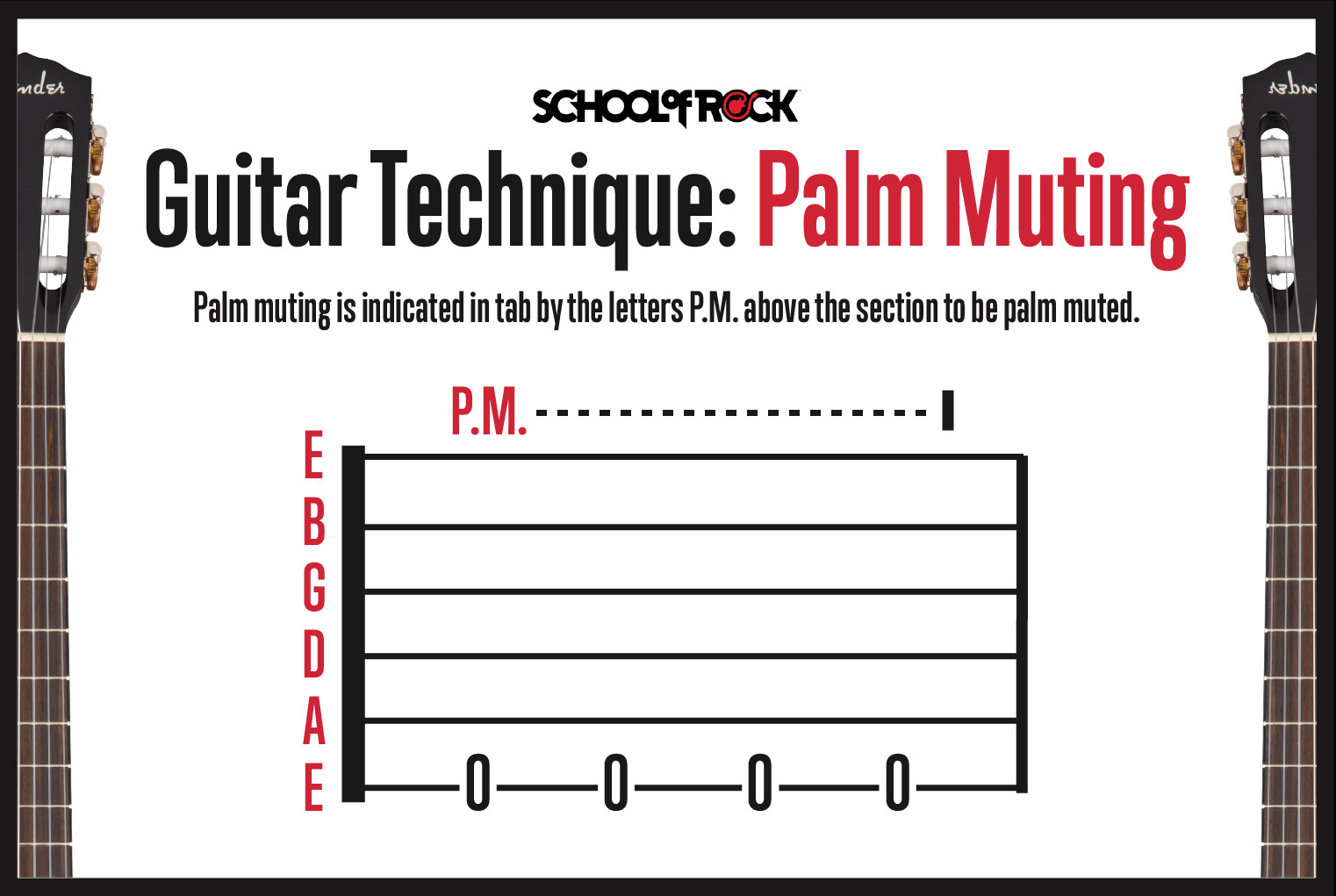 Guitar technique palm muting
Guitar technique palm muting
GUITAR TECHNIQUE: MUTED NOTES (Fretting Hand Muting)
Muted notes, distinct from palm muting, are achieved using the fretting hand. In guitar tab sheets, these notes are indicated by an “X” in place of a fret number. While the string is picked, the fretting hand lightly touches the string without fully pressing it down to the fretboard, resulting in a percussive, muted sound rather than a clear pitch.
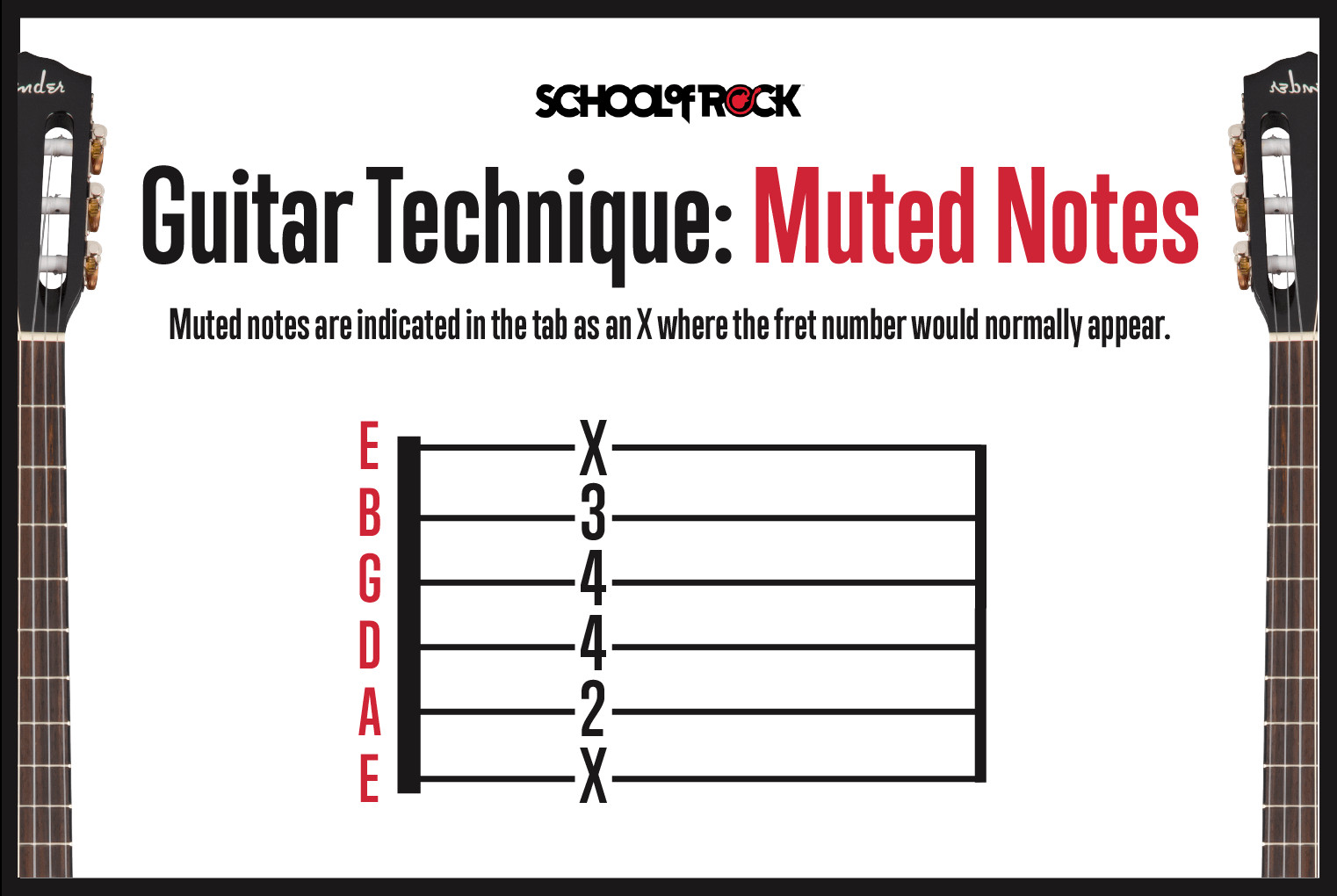 Guitar technique muted notes
Guitar technique muted notes
BENDING GUITAR STRINGS
String bending adds expressive, vocal-like qualities to guitar playing. In guitar tab sheets, bends are represented by a curved arrow over the note to be bent. The arrow often includes markings like “½” or “full,” indicating a half-step (one fret) or full-step (two frets) bend, respectively. These target pitches are often referred to as “target notes.”
HOW TO BEND GUITAR STRINGS
String bending involves pushing the string up or down parallel to the fretboard, rather than pressing directly down onto it. For most strings (except the low E), the bending motion is typically upwards, towards the ceiling. The low E string is usually bent downwards, towards the floor. The key to successful bending is applying smooth, consistent pressure throughout the bend.
GUITAR TECHNIQUE: BENDING GUITAR STRINGS
Most bends are executed using a combination of fingers for added strength and control. Typically, the ring finger is the primary fretting finger, with the middle and index fingers providing support. This multi-finger approach results in smoother bends and better pitch control.
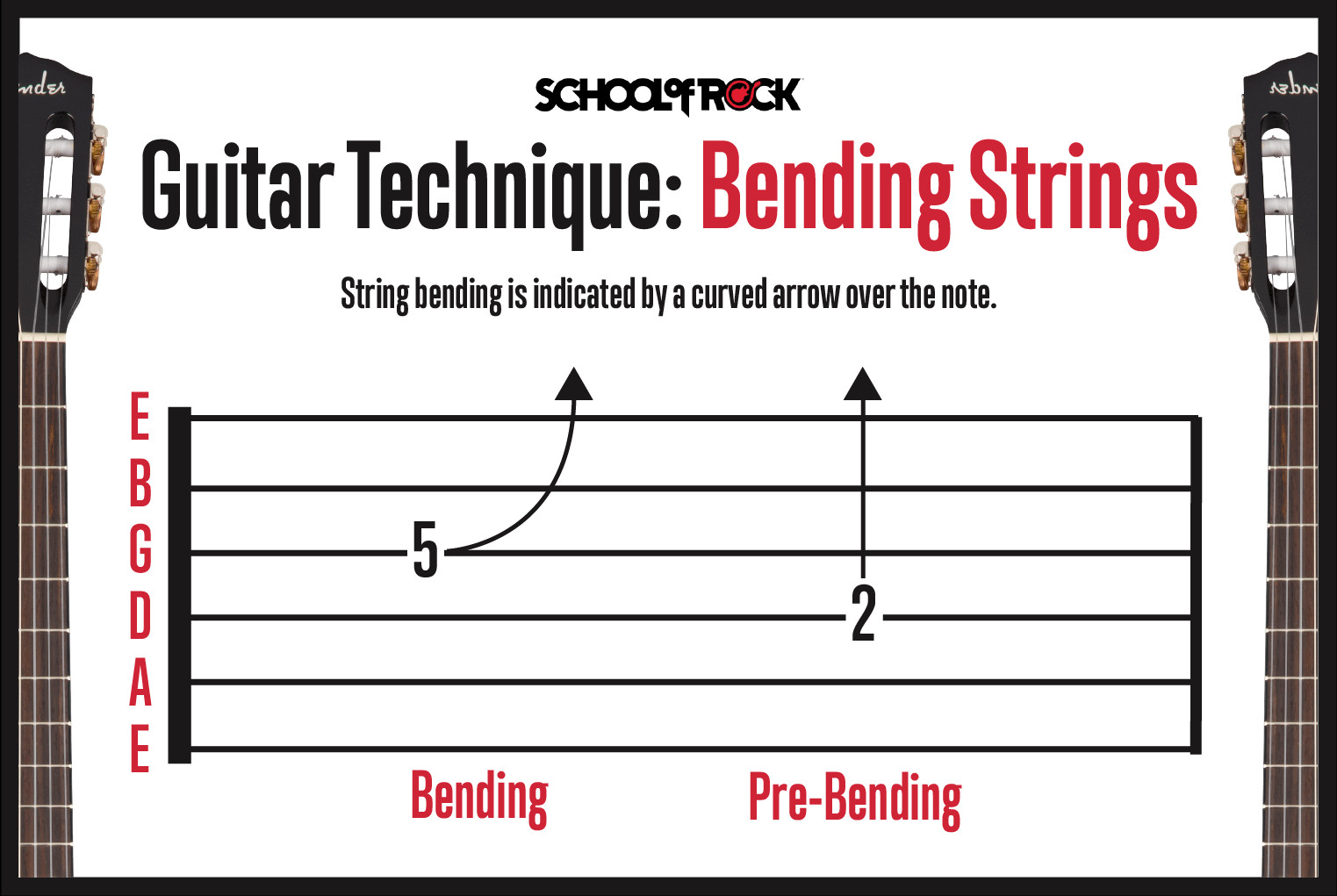 Guitar technique bending strings
Guitar technique bending strings
GUITAR TECHNIQUE: PRE-BENDING GUITAR STRINGS
Beginners learning how to read tab sheets for guitar might also encounter “pre-bends.” A pre-bend involves bending the string to the target pitch before picking the note. The tab notation shows a straight upward arrow indicating the bend amount (full, ½, etc.), followed by a curved arrow downwards, signifying the release of the bend back to the original fretted pitch after picking. Pre-bends can resolve back to the original note or bend further upwards to another target pitch.
SLIDING GUITAR NOTES
Sliding is another essential guitar technique, allowing for smooth transitions between notes. You can slide upwards to a higher note or downwards to a lower note. Sliding differs from bending as it involves moving your fretting finger along the fretboard to the target fret.
GUITAR TECHNIQUE: SLIDE UP
In guitar tab sheets, an upward slide is depicted by a line connecting the starting note to the ending note. If the slide is upwards to a higher pitch, the line often slants slightly upwards.
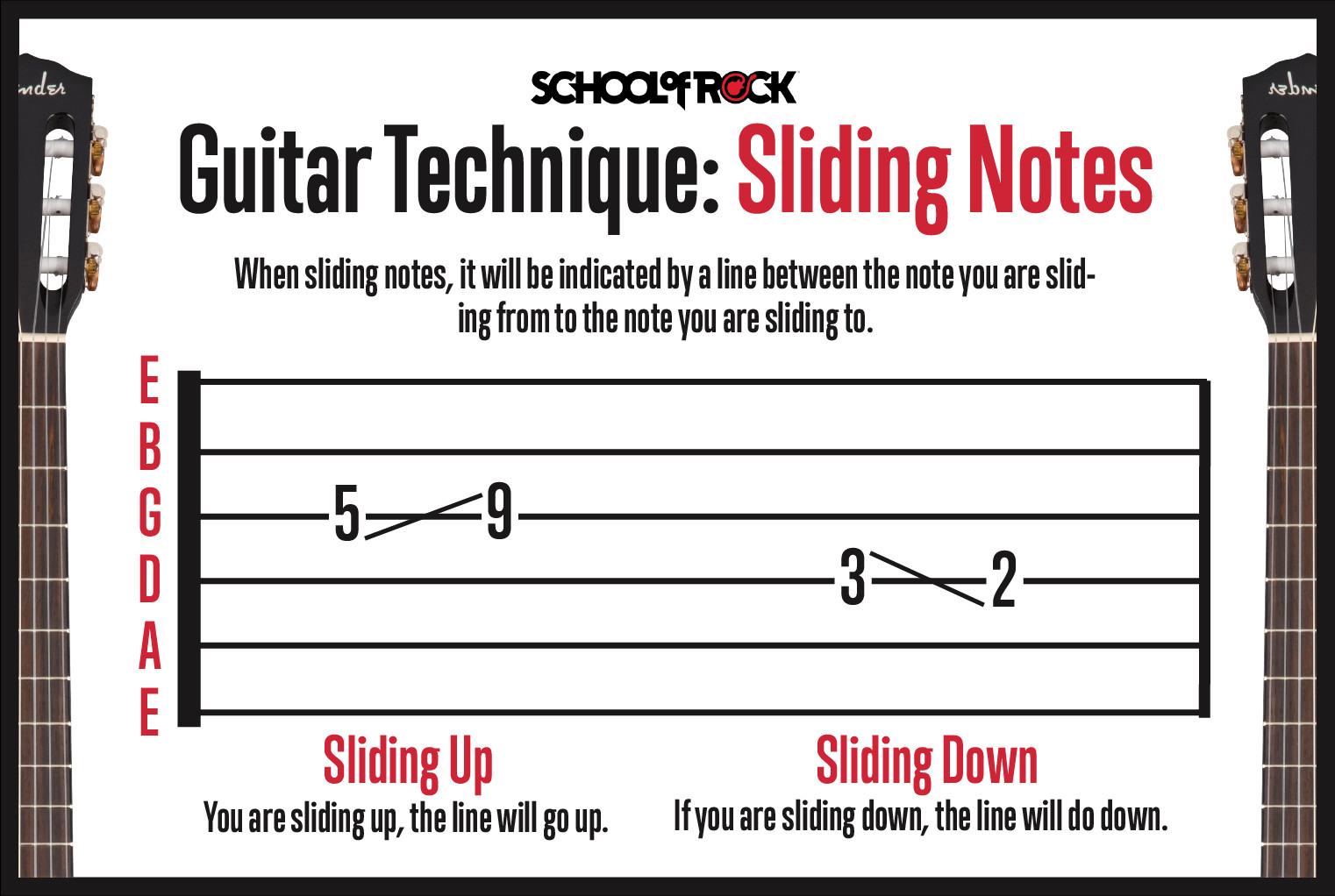 Guitar technique sliding notes
Guitar technique sliding notes
GUITAR TECHNIQUE: SLIDE DOWN
Conversely, a downward slide is also shown by a line between the starting and ending notes. If the slide is downwards to a lower pitch, the line may slant slightly downwards.
PLAYING HAMMER-ONS ON THE GUITAR
A hammer-on is a technique where you produce a note by “hammering” your fretting finger onto the string behind a fret, without picking the string again. The resulting note will be higher in pitch than the previous note. Hammer-ons can originate from an open string or a previously fretted note. In guitar tab sheets, hammer-ons are indicated by an “H” and a curved line connecting the initial note to the hammered-on note.
HOW TO PLAY HAMMER-ONS ON THE GUITAR
To execute a hammer-on, strike the string with your fretting finger with sufficient force to make the note sound clearly. This technique takes practice to achieve a strong, clear tone. It’s often easier to perform on electric guitars, especially at higher volumes. Practice starting with an open low E string and hammer-on to the third fret, holding the note to let it ring. Repeat this exercise on different strings and frets.
 Guitar technique hammer ons
Guitar technique hammer ons
PLAYING PULL-OFFS ON THE GUITAR
Pull-offs are the opposite of hammer-ons. Instead of hammering on, you “pull off” a fretted note, allowing a lower note (either an open string or a note fretted by another finger) to sound. Pull-offs are represented in guitar tab sheets by a “P” and a curved line connecting the pulled-off note to the resulting lower note.
HOW TO PLAY PULL-OFFS ON THE GUITAR
To perform a pull-off, fret a note, then pull your fretting finger off the string in a downwards or sideways motion, plucking the string just enough to sound the lower note. When executing pull-offs, ensure you “grab” enough of the string with your fingertip to produce a clear tone.
Hammer-ons and pull-offs can be combined in alternating sequences, creating a technique often referred to as a “trill.”
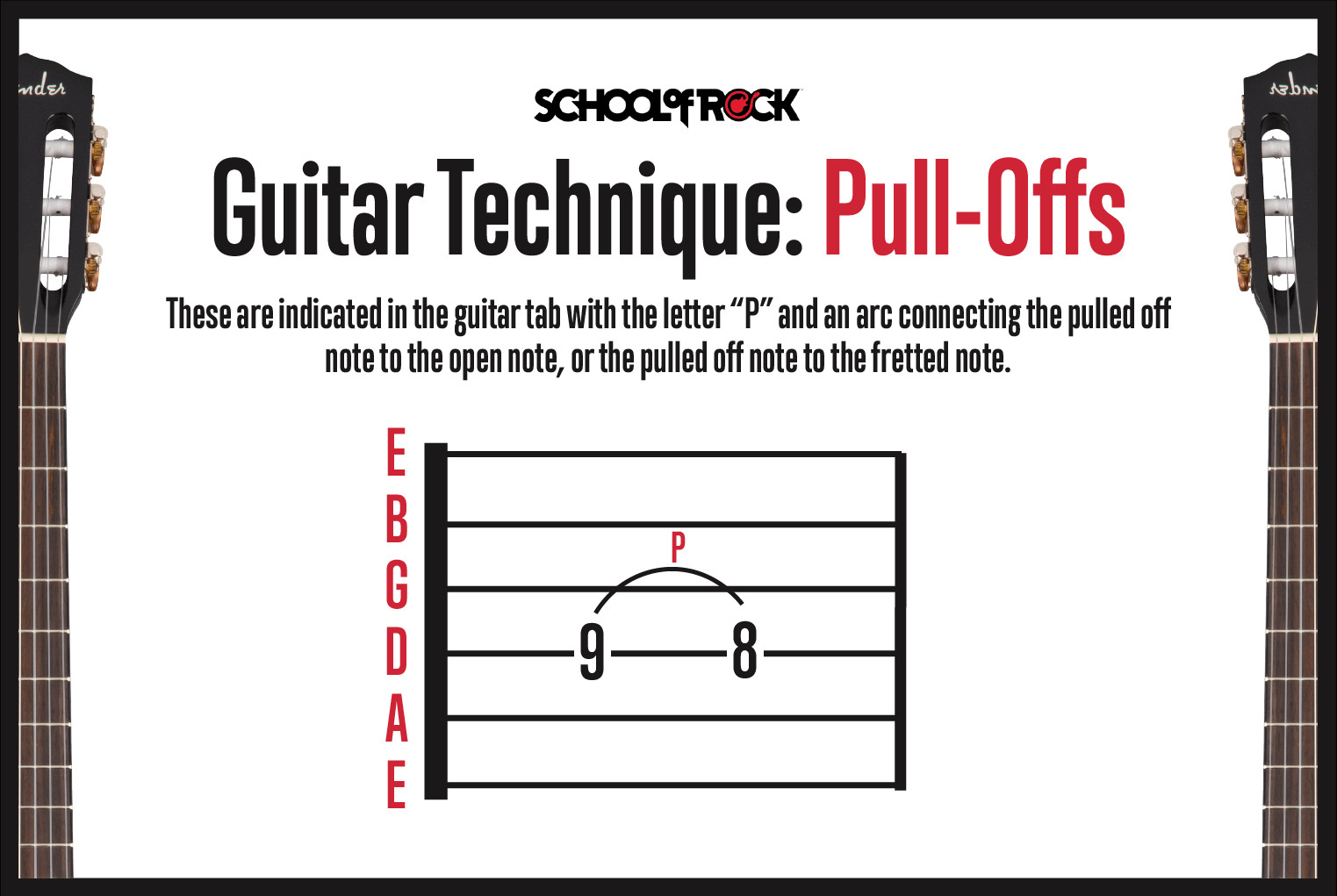 Guitar technique pull offs
Guitar technique pull offs
PLAYING VIBRATO ON THE GUITAR
Vibrato is a technique that adds expressiveness to notes by creating subtle, rapid variations in pitch. It involves repeatedly bending a note slightly and returning to the original pitch without releasing the fretting pressure. In guitar tab sheets, vibrato is shown as a zig-zag line above the staff. The length of this line often indicates the duration of the vibrato effect.
HOW TO PLAY VIBRATO ON THE GUITAR
Vibrato is similar to bending, but with smaller pitch variations. You can apply vibrato using a single finger or by using a main finger supported by others. Start practicing with a slow, smooth vibrato and gradually experiment with varying speeds for different expressive effects. Like bending, vibrato is a highly personal technique; each guitarist’s vibrato is unique, contributing to their individual playing style.
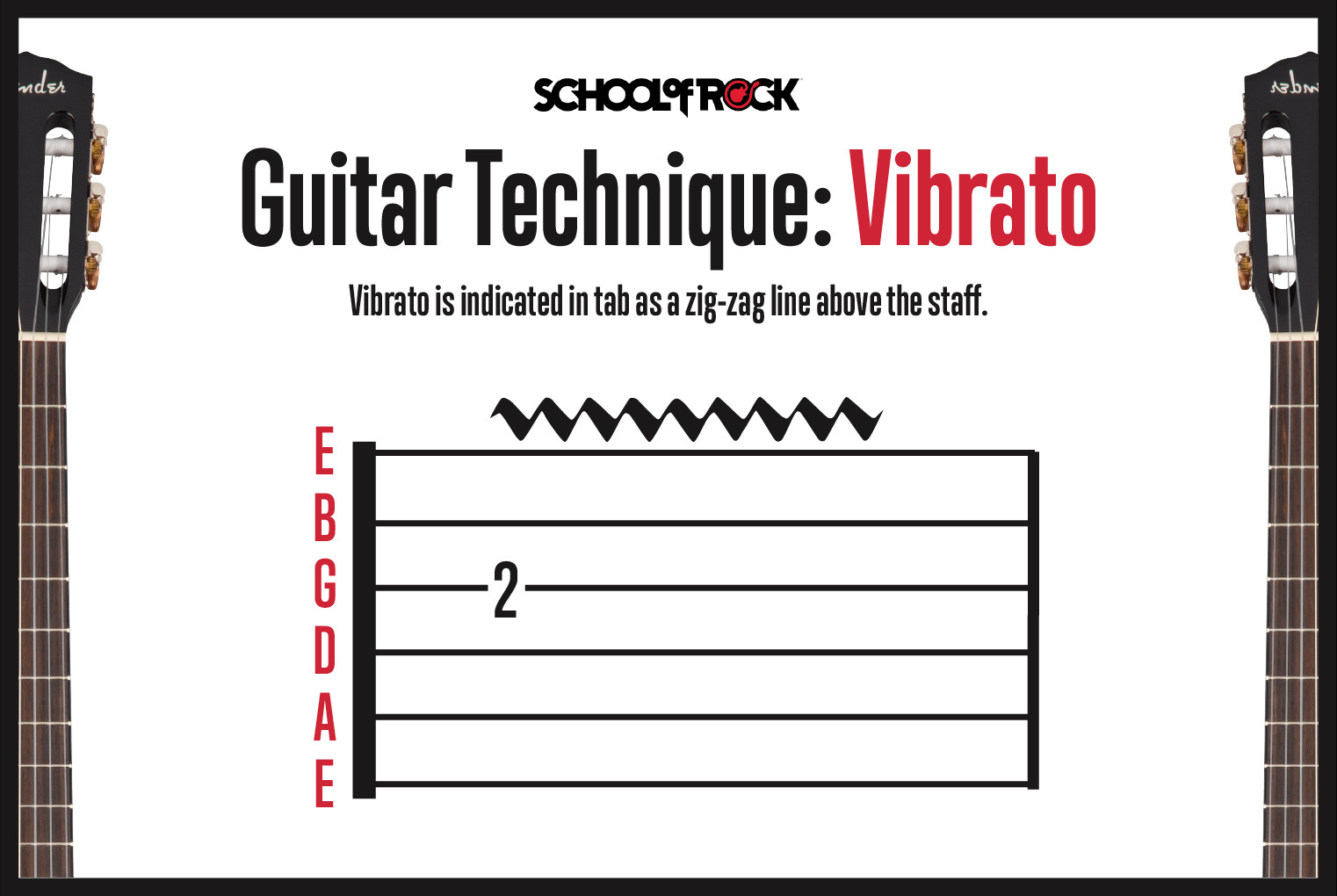 Guitar technique vibrato
Guitar technique vibrato
TAPPING GUITAR
Tapping is a technique where you fret notes with your regular fretting hand while also “tapping” notes on the fretboard with a finger of your picking hand, usually the index finger. The picking hand tap is essentially a variation of a hammer-on. In guitar tab sheets, tapping is notated by a “T” above the tapped note.
HOW TO FINGER TAP GUITAR
While popularized by Eddie Van Halen, tapping has roots in classical guitar. To finger tap, fret a note with your fretting hand and then “tap” a higher note on the same string with your picking hand’s index finger.
Finger tapping expands your playing range, allowing you to play intervals that are too wide to reach with just your fretting hand. Playing with overdrive or distortion and sufficient volume often enhances the clarity and impact of tapping. This technique also facilitates rapid playing, as you are effectively using both hands to fret notes.
 Guitar technique tapping notes
Guitar technique tapping notes
GUITAR TECHNIQUE: TWO-HANDED TAPPING
Two-handed tapping takes the tapping concept further. It involves both hands independently tapping notes on the fretboard without traditional picking. Often, the fretting hand taps bass notes while the picking hand taps melody or solo lines, creating complex and layered textures.
STRUMMING GUITAR NOTES
When strumming chords, two fundamental strumming directions are used: downstrokes and upstrokes.
Downstrokes are played from the lower strings towards the higher strings using a downward motion. In guitar tab sheets, downstrokes are represented by a symbol resembling a thick horizontal line with two downward “legs” on either side.
Upstrokes are the opposite, played from the higher strings towards the lower strings with an upward motion. In guitar tab sheets, upstrokes are notated by a “V” shaped symbol.
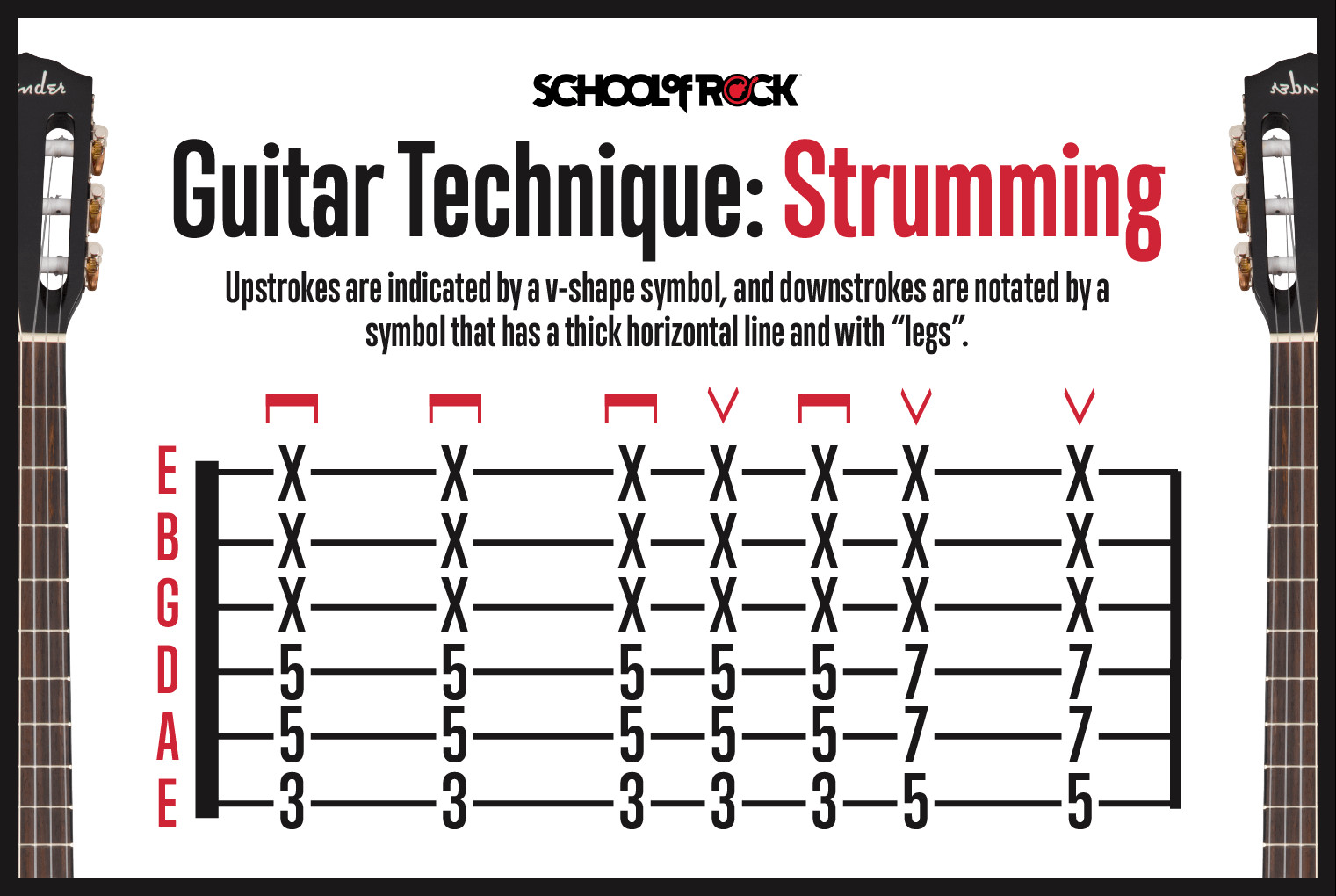 Guitar technique strumming
Guitar technique strumming
HOW TO STRUM GUITAR NOTES
Strumming patterns vary depending on the song’s rhythm. You can use a constant down-up strumming pattern or various combinations of downstrokes and upstrokes. Songs with an eighth-note rhythm are often counted as “1 and 2 and 3 and 4 and…”. Many songs utilize alternating downstrokes and upstrokes in an eighth-note rhythm, with downstrokes on the numbered beats (1, 2, 3, 4) and upstrokes on the “ands.”
GUITAR TECHNIQUE: PLAYING DOWNSTROKES AND UPSTROKES (Single Notes)
The same downstroke and upstroke notation applies to single notes in guitar tab sheets. Downstrokes, indicated by the horizontal bar symbol, are played with a downward pick motion. Upstrokes, marked with a “V,” are played with an upward pick motion.
READY TO MASTER MORE GUITAR TECHNIQUES?
Now that you’ve learned how to read tab sheets for guitar and understand various guitar techniques, you’re well-equipped to start playing! From beginners to advanced players, guitarplayers.net is dedicated to helping you reach your full potential. Our comprehensive resources and guides will help you quickly learn to play your favorite songs.
Eager to find guitar tab sheets? Whether you’re looking for easy songs for beginners or challenging pieces for experienced players, we’ve got you covered. Explore a vast collection of high-quality sheet music and elevate your guitar journey!
Thinking about getting a new guitar? Check out our Guitar Buying Guide
